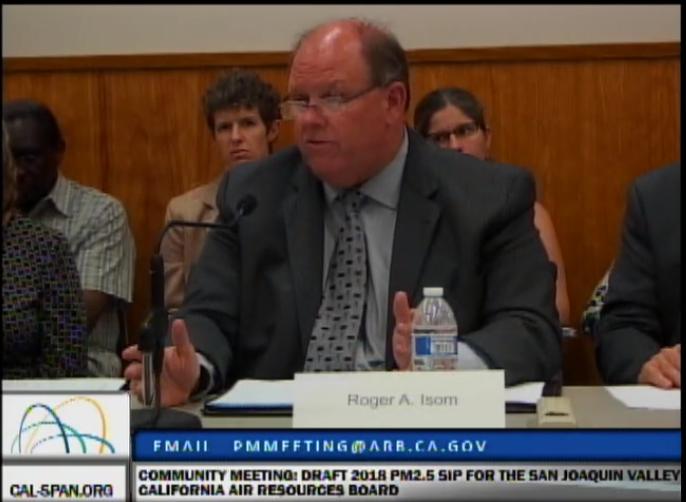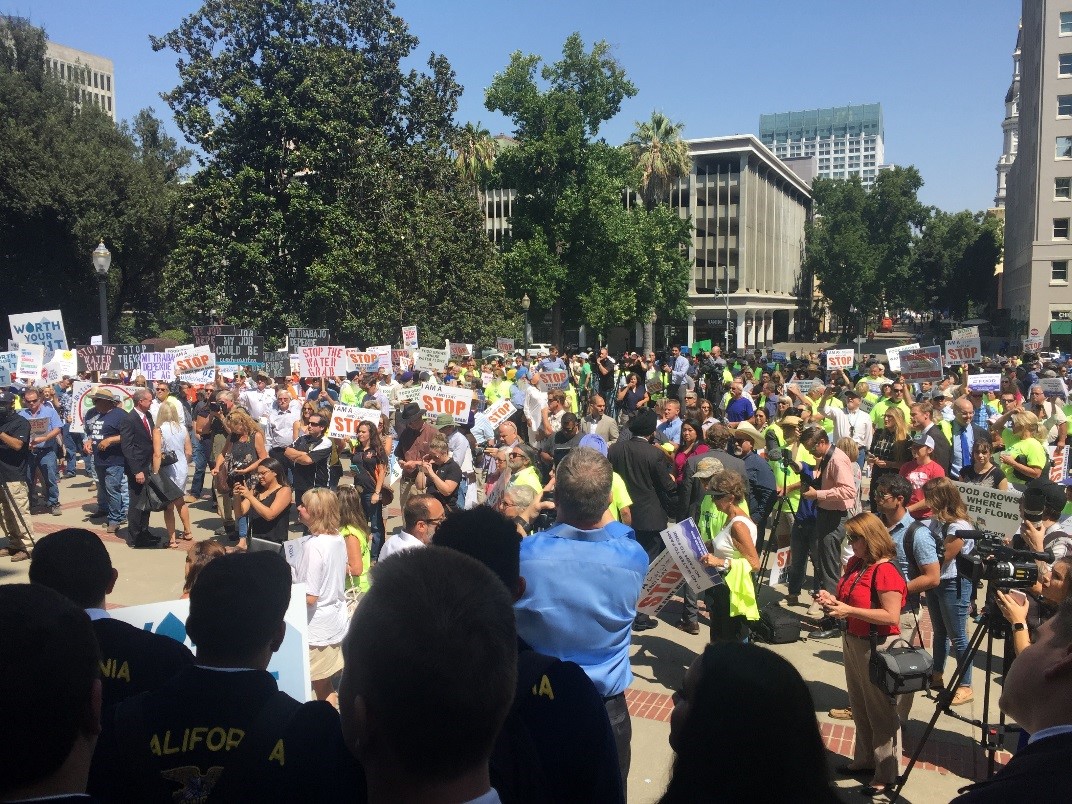With little notice and even less transparency, in typical “last week of session fashion”, the legislative conference committee tasked with addressing the wildfire and utility liability issue jammed through a massive bailout for PG&E standing with their shareholders over ratepayers, including businesses and homeowners in California who will experience skyrocketing energy bills. The legislation, SB 901 would require ratepayers to cover whatever damages are beyond the cap placed on PG&E, even if PG&E is found negligent in the massive 2017 fires. At $10 billion in liability, customers will pay an additional ½ cent per kWh for every kilowatt hour for the next 20 years! SB 901 will be voted by both the Assembly and Senate Friday night, and the Association is adamantly opposed. Association President/CEO Roger A. Isom stated “Our members cannot afford any more rate increases to the already highest industrial electricity rates in the country. To put this on our backs is unequivocally unacceptable. We refuse to pay for their negligence and wholeheartedly oppose this legislation.”
NEWS & ISSUES
Association Pushes Back on Plan to Replace 12,000 Tractors in Five Years
This week, the California Air Resources Board (CARB) held a nighttime “community meeting” in Fresno to discuss the PM2.5 State Implementation Plan (SIP) for the San Joaquin Valley. And what attendees heard was a repeat of an earlier meeting by the San Joaquin Valley Air Pollution Control District and not good news for agricultural interests. At the Air District level, attendees learned that Tier 3 irrigation pump engines will now have to be replaced with Tier 4 engines or electric motors. In addition, the Air District is going to tighten the Conservation Management Practices regulations to control fugitive dust from farms, specifically tightening restrictions on land preparation and how lands are fallowed. On the State side, CARB confirmed the information released recently stating they will be regulating tractors and harvesters for the first time. CARB is looking at replacing 12,000 tractors by the end of 2024! While they will focus on the use of incentives first, it was made abundantly clear there will be a “drop dead date” by which older tractors and harvesters will have to be replaced. The SIP relies upon at least $55 million per year in funding coming from Cap and Trade monies through 2024. Speaking on the Industry Panel at the special meeting Association President/CEO Roger Isom said that while we appreciate the incentive approach, we have concerns with relying upon “yet unsecured funds” to replace 12,000 tractors by 2025. Isom also provided testimony opposing the fugitive dust and engines requirements. The plan is expected to be adopted by the SJVAPCD in November and the ARB in December.
Pink Bollworm Program- Silverleaf Whitefly Report 8/13/18-8/24/18
The California Department of Food and Agriculture’s Pink Bollworm Program has released its report for monitoring Silverleaf Whitefly. The program monitored for whitefly and other cotton pests from August 13, 2018 to August 24, 2018. For the full report, please follow the link below:
USDA Announces Details of Assistance Program for Farmers Impacted by Trade Issue
U.S. Secretary of Agriculture Sonny Perdue today announced details of actions the U.S. Department of Agriculture (USDA) will take to assist farmers in response to trade damage from unjustified retaliation by foreign nations. USDA will authorize up to $12 billion in programs, consistent with our World Trade Organization obligations. These programs will assist agricultural producers to meet the costs of disrupted markets:
- USDA’s Farm Service Agency (FSA) will administer the Market Facilitation Program (MFP) to provide payments to corn, cotton, dairy, hog, sorghum, soybean, and wheat producers starting September 4, 2018. An announcement about further payments will be made in the coming months, if warranted.
- USDA’s Agricultural Marketing Service (AMS) will administer a Food Purchase and Distribution Program to purchase up to $1.2 billion in commodities unfairly targeted by unjustified retaliation. USDA’s Food and Nutrition Service (FNS) will distribute these commodities through nutrition assistance programs such as The Emergency Food Assistance Program (TEFAP) and child nutrition programs.
- Through the Foreign Agricultural Service’s (FAS) Agricultural Trade Promotion Program (ATP), $200 million will be made available to develop foreign markets for U.S. agricultural products. The program will help U.S. agricultural exporters identify and access new markets and help mitigate the adverse effects of other countries’ restrictions.
Background on Market Facilitation Program:
MFP is established under the statutory authority of the Commodity Credit Corporation (CCC) and administered by FSA. For each commodity covered, the payment rate will be dependent upon the severity of the trade disruption and the period of adjustment to new trade patterns, based on each producer’s actual production. Interested producers can apply after harvest is 100 percent complete and they can report their total 2018 production. Beginning September 4th of this year, MFP applications will be available online at www.farmers.gov/mfp. Producers will also be able to submit their MFP applications in person, by email, fax, or by mail. Eligible applicants must have an ownership interest in the commodity, be actively engaged in farming, and have an average adjusted gross income (AGI) for tax years 2014, 2015, and 2016 of less than $900,000. Applicants must also comply with the provisions of the “Highly Erodible Land and Wetland Conservation” regulations. On September 4, 2018, the first MFP payment periods will begin.
Market Facilitation Program
| Commodity | Initial Payment Rate | Est. Initial Payment**
(in $1,000s) |
| Cotton | $0.06 / lb. | $276,900 |
| Corn | $0.01 / bu. | $96,000 |
| Dairy (milk) | $0.12 / cwt. | $127,400 |
| Pork (hogs) | $8.00 / head | $290,300 |
| Soybeans | $1.65 / bu. | $3,629,700 |
| Sorghum | $0.86 / bu. | $156,800 |
| Wheat | $0.14 / bu. | $119,200 |
| Total | $4,696,300 |
** Initial payment rate on 50% of production
The initial MFP payment will be calculated by multiplying 50 percent of the producer’s total 2018 actual production by the applicable MFP rate. If CCC announces a second MFP payment period, the remaining 50 percent of the producer’s total 2018 actual production will be subject to the second MFP payment rate. MFP payments are also capped per person or legal entity at a combined $125,000 for corn, cotton, sorghum, soybeans and wheat. For more information on the MFP, visit www.farmers.gov/mfp or contact your local FSA office, which can be found at www.farmers.gov.
CARB Wants 12,000 Tractors Replaced in San Joaquin Valley by 2024!
In a meeting yesterday at the Association offices, the California Air Resources Board (CARB) unveiled is plan to require the replacement of 12,000 Tier 0, 1, and 2 tractors by 2024. This requirement is contained in their portion of the measures to be contained in the State Implementation Plan (SIP) for the San Joaquin Valley to achieve attainment of the National Ambient Air Quality Standard for PM2.5. This particular measure, called the “Accelerated Turnover of Agricultural Tractors” would use existing and new incentive funding programs to help accelerate the natural turnover of agricultural equipment. These programs include the Carl Moyer Program, the USDA NRCS EQIP Funding and the new FARMER Program funding. Unfortunately, it also assumes that we will be able to secure FARMER from the Cap & Trade program beyond 2019, which is all we have a commitment for. This puts ag in a quandary, because of the back stop that CARB is also considering; another measure entitled “Cleaner In-Use Agricultural Equipment” which is designed to increase the penetration of cleaner agricultural equipment, including advancing zero-emission technology (aka “electric”) where feasible. This program appears to be a mandatory replacement measure, that allows for incentive funds to be used, but will become mandatory if the necessary reductions are not achieved through the incentive funding. This will be heard in a workshop in Fresno next Tuesday, August 28th, where the Association will be presenting comments.
Huge Turnout for Sacramento Water Rally
Over 1,000 farmers, farmworkers, business owners, teachers, medical agency staff, students and elected officials showed up at the Capitol to protest the “State Water Grab” contained in the State Water Resources Control Board’s (SWRCB) proposed Water Quality Control Plan for the San Francisco Bay/Sacramento-San Joaquin Delta Estuary (the “Bay-Delta Plan”) and the supporting proposed final Substitute Environmental Document (“Final SED”). The proposal would require “unimpaired flows” on the Stanislaus, Tuolumne and Merced rivers during critical times of the year, which would ultimately mean a loss of 40% to 60% of the water used those areas. This will be devastating not only to agriculture but to everything in Merced, Stanislaus and San Joaquin Counties. In interviews following the Rally, Association President/CEO Roger Isom, who participated in the Water Rally, stated “this is not only a water grab, it is a clear signal that the State Water Board has no consideration for life in the San Joaquin Valley. Anyone who questions that should look no further to the west side of the San Joaquin Valley devastated by similar measures that eliminated water coming to that area. Fresno County went from being the number one cotton producing county in the world to outside of the top 100. More than 20 cotton gins and the over 1,000 people involved in those operations lost their jobs, and the populations of salmon and delta smelt are no better off today, then they were back then. This new proposal will have the same impact to the economies of Merced, Stanislaus and San Joaquin counties and towns like Denair and Ballico will look like Mendota and Firebaugh. Today is the day we stand up and say enough is enough. And today the state’s agricultural industry did just that!”
Final Mapped California Cotton Acreage
The Pink Bollworm Program under the California Department of Food and Agriculture has released their final mapped numbers for 2018, including the Pima and Upland acreage splits. Final acreage numbers for California put Pima at 209,945 acres and Upland at 47,925 acres for a total of 257,870 acres statewide.
This represents a 0.1% increase in Pima acreage and a 44.6% decrease in upland acreage as compared to 2017. This represents a 12.6% decrease in overall cotton acreage for 2018.
Pink Bollworm Program- Silverleaf Whitefly Report 7/30/18-8/10/18
The California Department of Food and Agriculture’s Pink Bollworm Program has released its report for monitoring Silverleaf Whitefly. The program monitored for whitefly and other cotton pests from July 30, 2018 to August 10, 2018. For the full report, please follow the button link below:
Ratepayer Protection Network
In July the Ratepayer Protection Network group was established to protect ratepayers, improve wildfire preparedness and response and advocate on behalf of ratepayers as Sacramento considers new policies to deal with California wildfires. The California Cotton Ginners and Growers Association has joined the Ratepayer Protection Network to help make sure our issues are addressed.
Responding to the escalating number and costs of California wildfires, the State Legislature formed a Conference Committee on Wildfire Preparedness and Response, responsible for improving rules for utilities to prevent, mitigate and respond to wildfires caused by utility equipment.
This Conference Committee will set the stage for how California handles future major incidents, including who is held accountable for covering the costs of catastrophic wildfires. They will be meeting throughout August to discuss various topics.
As you are well aware, we Californians already pay some of the highest utility rates in the country. It is likely that current legislation would worsen these burdens by providing a bailout for utilities and major new costs – all at the expense of California families and businesses. The Ratepayer Protection Network is giving a voice to ratepayers.
California’s ratepayers urge the Conference Committee to protect ratepayers from these unfair impacts and hold utilities and their shareholders accountable for making their systems safer.
To learn more about the Ratepayer Protection Networks please visit: www.RatepayerProtection.Network
Cotton Board Advisor Positions Available
The Cotton Board has two new advisory positions designed to represent the voices and issues faced by under-represented cotton producers such as minorities and the youth. Ideal candidates should familiarize themselves with the organization, attend and participate in Cotton Board meetings, and remain ethical and confidential while serving as an ambassador for the program.
Advisors are appointed by the Secretary and are non-voting. Their three-year term will begin at the start of 2019. Advisors are welcome to all of the Cotton Board’s regularly scheduled meetings which are held in March, August, and December each year. Travel and participation expenses will be reimbursed by the Cotton Board.
For interested candidates, please refer to the information below and complete the fillable form attached. Completed forms are to be submitted to Tom Eubank via e-mail at teubank@cottonboard.org no later than Wednesday September 5th.



